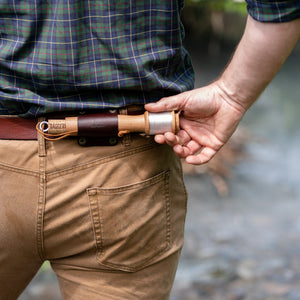Couch-2-Campsite #5 Setting Up Your Camping Shelter

Jessica Vozel
New to the outdoors. Not new to writing.
Jessica here, taking over the Couch to Campsite series as a real-life C2C test case who started at zero a few months ago, without even a backpack or a pair of hiking boots to call my own. Over the last few months, I’ve been slooowly gearing up for my first overnight backpacking trip.
As someone who has never spent the night outdoors with only what I can carry on my back, every gear decision has felt consequential—a literal matter of life and death in the face of nature's unforgiving fury.
As I progress, I have realized that nature isn't quite that ruthless (at least not all the time) and humans are much more adaptable than we imagine. It's unlikely that one night outdoors in normal circumstances will kill us, even if we do choose the "wrong" sleep system.
Speaking of which, in this post I’ll talk a bit about why I chose a tarp for my starter sleep configuration, and point you toward some of my favorite resources for learning how to use tarps for camping shelter.
But first, let’s recap the C2C series so far. We have:
2. Examined the reasons to get out there
3. Learned how to build a fire
4. Practiced boiling water for cooking and water purification
5. Learned how to tie a few multi-purpose knots.
With only a boiling vessel, some food and a lighter or matches, we've built a solid foundation for surviving in the wilderness. So let’s move up a rung on the hierarchy of needs and learn how to shelter ourselves for the night.

Tent or Tarp or... Nothing?
In some ways, my early decision about what to sleep on/under really did feel like it would begin to define my perspective about the outdoors. The thought process about the different options went something like this:
Tarps are versatile, inexpensive, and a little intimidating—there is actual open space between my body and the elements! And they require a more robust knowledge base, which is intimidating when starting out. On the other hand, tarps are a nod toward a minimalist approach to the outdoors, which I appreciate and want to orient toward.
Tents offer the feeling of full enclosure and are more familiar. I’ve never been backpacking, but I’ve been tent camping plenty of times (with someone else setting up the tent, admittedly). Cons include cost, added weight to my pack, and a lack of options to make the tent work for my specific situation.
Then there's nothing.
In the right conditions, it's entirely possible to fulfill the romantic notion of "sleeping under the stars" without anything between you and the sky or the ground.
But shelters protect you from precipitation and insulate you from moisture in the ground, both of which suck away heat from your body and make it unpleasant (or in extreme cases, dangerous) to sleep.
At the very least, you should have the option of shelter with you when you venture into the outdoors for overnights, because of those worst-case scenarios.
Eventually, I decided to go with a tarp. The nicest one I could find cost significantly less than even a lower-quality tent. Plus, I’m only 5’1,” which means I have even more options for configurations that would keep me covered (more on that in a minute).
I also appreciated the versatility of tarps—I can use them in conjunction with a tent or hammock, too.
Learn to Construct Your Tarp Shelter
As it turns out, I underestimated the challenges of setting up a tarp shelter for camping. The experts I consulted beforehand seem to effortlessly glide from one step to the next, making the whole process appear simple—even fun!
I had the false hope that I would somehow manage to be just as fluent as these experts on my first try. And then, poof! I'd be an outdoorsperson, ready to survive in the wild.
In truth, I didn't even know how to tie a rope around a tree (which was my first
challenge).
In short, fellow newbies: please know that your first time trying to put up a tarp shelter by yourself will not be effortless. But therein lies the beauty, too; mastery from the very beginning means there is nothing to learn, and no sense of accomplishment waiting for you as you hone your skills.
One thing I learned? The tried-and-true methods of outdoor experts are a great starting point, but that doesn't mean we have to imitate them exactly. There's a place for intuition and creativity in all of this, too.
Below is the shelter I landed on for me—a modified A-frame, using my 8x10 tarp, that easily covers all 5'1" of me and is low-profile enough to include a ground sheet.
Essentially, I combined a couple of the options on the TA Outdoors video above . He covers everything you need to know to construct this tarp shelter—from tying flexible knots to anchor your ridgeline to the trees staking down your corners.

By keeping the tarp low-profile, it can double as a groundsheet. No need to pack anything extra!

I can't quite sit up with this configuration, but there's plenty of legroom.

Looping sticks through my prusick knot/tarp tie-outs helps to create toggles for adjusting and tightening.
Now, for my next challenge: actually spend the night outdoors in one of these (after all, a half-hour nap doesn't quite afford the full experience). Follow along as I get off the couch and into the wild.
Find calm and confidence.
No matter where you are in your journey to reconnect with the wilderness, Daggerfish has the minimalist, intuitive gear & tools to help you get closer.




















